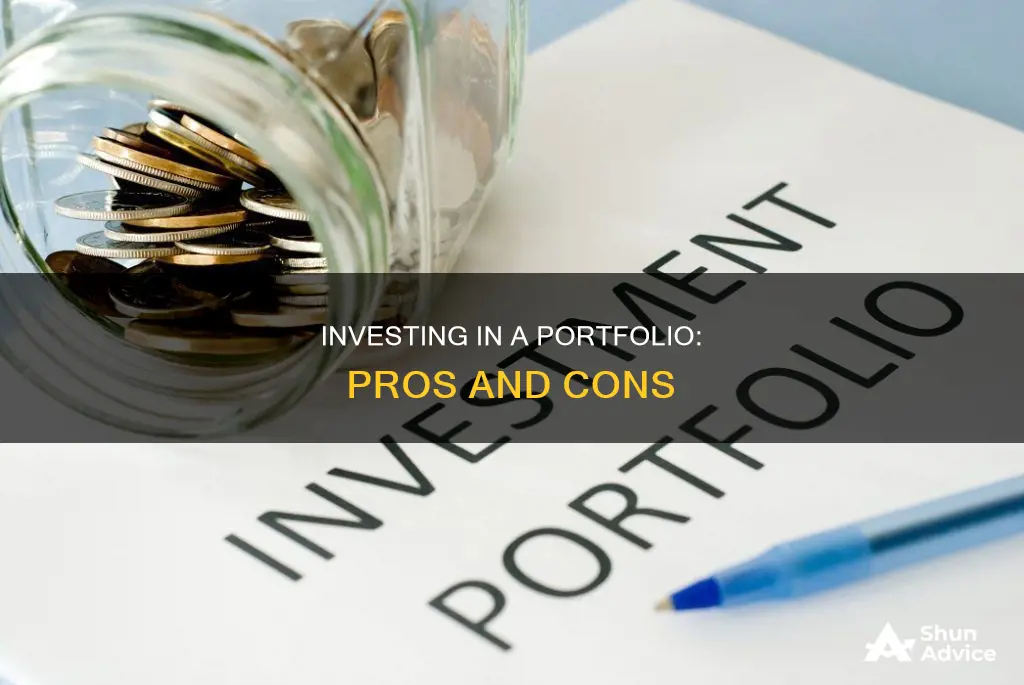
Investing in a portfolio is a great way to secure your financial future. A portfolio is a collection of invested assets such as stocks, bonds, and funds. The most important thing to consider when creating a portfolio is your personal risk tolerance, or how much investment loss you can stomach in pursuit of higher returns. Your risk tolerance is tied to how much time you have before reaching your financial goals, and how you handle market volatility. If your goal is years away, you have more time to recover from market lows, which will allow you to take advantage of the market's upward trend.
To build an investment portfolio, you'll need to decide how much help you want, choose an account that works for your goals, select investments that align with your preferences and goals, determine the best asset allocation for you, and rebalance your portfolio as needed.
| Characteristics | Values |
|---|---|
| Risk | Higher risk = higher return |
| Time | The longer you invest, the more you're likely to earn |
| Diversification | A portfolio should be diversified to reduce risk |
| Management | Robo-advisors can be used to manage a portfolio |
| Taxes | Tax implications should be considered when rebalancing |
What You'll Learn

Risk tolerance and time horizon
When deciding whether to invest in a portfolio, it's important to consider your risk tolerance and time horizon. These factors will help determine the type of investments that are suitable for you.
Risk tolerance refers to the degree of risk an investor is willing to accept, given the potential for gains or losses in the value of their investments. It is influenced by factors such as age, investment goals, and income. An aggressive investor with a high-risk tolerance is comfortable with potential losses and seeks higher returns, often investing in stocks and equity funds. On the other hand, a conservative investor prefers guaranteed returns and lower risk, typically investing in bonds, income funds, and bank certificates of deposit (CDs). Moderate investors aim to balance risk and returns, diversifying their portfolios with a mix of stocks and bonds.
Time horizon, on the other hand, refers to the period an investor expects to hold an investment before needing the money. This is influenced by investment goals and strategies. Short-term horizons are typically fewer than five years and are suitable for those approaching retirement or needing cash soon. Medium-term horizons range from three to ten years and are often associated with goals like saving for a home or education. Long-term horizons are over ten years and are common for retirement savings, allowing for greater risk-taking.
The relationship between time horizon and risk is crucial. Generally, a longer time horizon enables investors to be more aggressive and take on higher-risk investments, as they have more time to recover from potential losses. Conversely, shorter time horizons call for more conservative approaches to minimise the impact of market volatility.
It's important to note that financial markets tend to behave predictably over the long term but are highly unpredictable in the short term. Therefore, it is recommended to avoid investing short-term savings or emergency funds in volatile assets like stocks. Instead, opt for stable options such as high-yield cash management accounts or bond ETFs for near-term goals.
By understanding your risk tolerance and time horizon, you can make informed decisions about your investment portfolio, ensuring it aligns with your financial goals, risk appetite, and time frame.
Structuring an Investment Portfolio: Strategies for Success
You may want to see also

Diversification
Benefits of Diversification
Tips for Diversification
- Spread the Wealth: Invest in a variety of companies across different industries, countries, and risk profiles. Consider investing in commodities, exchange-traded funds (ETFs), and real estate investment trusts (REITs). Limit yourself to a manageable number of investments, such as 20-30 different stocks.
- Consider Index or Bond Funds: Index funds and fixed-income funds offer long-term diversification benefits. Index funds aim to match the performance of a specific index, like the S&P 500, and have low fees. Fixed-income funds, such as bonds, help reduce overall risk and volatility.
- Keep Building Your Portfolio: Regularly add to your investments. A strategy like dollar-cost averaging can help smooth out market volatility by investing a fixed amount at regular intervals, buying more shares when prices are low.
- Know When to Get Out: Stay informed about your investments and overall market conditions. Be prepared to cut losses and sell underperforming investments when necessary.
- Monitor Commissions: Be aware of the fees charged by different investment platforms and brokers. Trading stocks and ETFs may now have $0 commissions, but trading mutual funds, illiquid stocks, and alternative asset classes often incur fees.
- Asset Allocation: Allocate your investments across different asset classes, such as stocks, bonds, cash, and alternative investments. The specific allocation depends on your age, risk tolerance, and financial goals. Younger investors can take on more risk by investing a larger proportion of their portfolio in stocks, while older investors may opt for more conservative investments like bonds.
- Rebalancing: Periodically review and rebalance your portfolio to ensure it aligns with your investment goals and risk tolerance. If certain investments have grown significantly, consider selling some to reinvest in other areas to maintain a balanced portfolio.
Risks of Over-Diversification
While diversification is beneficial, it is possible to over-diversify a portfolio. Over-diversification occurs when adding more investments increases overall risk and reduces expected returns. This can happen when there are too many securities in a portfolio or when closely correlated securities are added. It is important to find a balance between diversification and focused investing.
In conclusion, diversification is an essential strategy for investors to manage risk and maximise returns. By following these tips and maintaining a well-diversified portfolio, investors can improve their chances of long-term investment success.
Saving and Investment: Understanding the Fundamentals
You may want to see also

Asset allocation
Understand Your Financial Situation and Goals:
Consider factors such as your age, investment horizon, capital available, and future income needs. For example, a young college graduate starting their career will have different investment goals and risk tolerance compared to someone closer to retirement age.
Evaluate Your Risk Tolerance:
Are you comfortable with taking on higher risks for potentially greater returns? Aggressive portfolios tend to allocate more towards equities, while conservative portfolios favour bonds and other fixed-income securities. It's important to strike a balance between risk and return that aligns with your personal situation.
Diversify Your Portfolio:
Diversification is a key investment strategy, which means not putting all your eggs in one basket. Invest across different asset classes, such as stocks, bonds, mutual funds, exchange-traded funds (ETFs), and real estate investment trusts (REITs). Diversification helps to reduce overall risk and can lead to bigger rewards.
Regularly Reassess and Rebalance:
Your portfolio should be dynamic and adapt to changing market conditions and your evolving financial situation. Periodically review the performance of your investments and adjust their weightings as necessary. This ensures your portfolio remains aligned with your risk tolerance and financial goals.
Consider Your Time Horizon:
Your investment horizon, or how long you plan to invest for, is an important factor in asset allocation. Generally, longer investment horizons can accommodate higher-risk investments, as there is more time to recover from potential losses.
By carefully considering these factors and constructing a well-diversified portfolio, you can optimise your investments for potential growth while managing risk effectively. Remember, it's crucial to regularly monitor and adjust your asset allocation to stay on track with your financial goals.
Explore Saving and Investment Options for Your Future
You may want to see also

Investment types
Investment portfolios are a collection of financial investments like stocks, bonds, commodities, cash, and cash equivalents, including closed-end funds and exchange-traded funds (ETFs).
Aggressive Portfolio
An aggressive portfolio seeks outsized gains and accepts the outsized risks that go with them. Stocks in this type of portfolio have a high beta, or sensitivity to the overall market. Investors in this category seek out companies in the early stages of their growth that have a unique value proposition.
Defensive Portfolio
Defensive stocks do not usually carry a high beta. They are relatively isolated from broad market movements. Defensive stocks do well in bad times as well as good times. Companies that make products that are essential to everyday life are considered defensive stocks.
Income Portfolio
An income portfolio focuses on investments that make money from dividends or other types of distributions to stakeholders. Real estate investment trusts (REITs) and master limited partnerships (MLP) are examples of income-producing investments.
Speculative Portfolio
Speculative portfolios are the closest to gambling. They involve taking more risk than any other type of portfolio. Speculative plays could include initial public offerings (IPOs) or stocks that are rumoured to be takeover targets.
Hybrid Portfolio
Building a hybrid portfolio requires venturing into other investments such as bonds, commodities, real estate, and even art. There is a great deal of flexibility in the hybrid portfolio approach. Traditionally, this type of portfolio would include a core of blue-chip stocks and some high-grade government or corporate bonds.
Savings vs. Investment Institutions: Where Should Your Money Go?
You may want to see also

Robo-advisors
- Wealthfront: This robo-advisor has an investment and money management product for any type of investor. With low fees and a low required minimum investment of $500, plus customisable automated portfolios, it's easy to see why it's a popular choice.
- Betterment: Betterment offers a powerful combination of goal-based tools, affordable management fees and no account minimum.
- SoFi Automated Investing: SoFi doesn't charge an investment management fee, and investors can begin investing with just $1.
- M1 Finance: M1 Finance is a one-of-a-kind investment portal suitable for strategic investors who want access to customised expert theme-focused strategy portfolios.
- Acorns: Acorns is known for its automatic round-ups that make saving and investing easy.
- Ellevest: Ellevest was designed for women investors to provide financial management aligned with their specific career and life situations.
- ETRADE Core Portfolios: ETRADE Core Portfolios provides a solid robo-advisor platform with a user-friendly mobile app.
- Merrill Guided Investing: Merrill Guided Investing benefits from integration with the Merrill Lynch and Bank of America brand and resources.
Diversifying Investment Portfolios: Strategies for Balancing Risk and Returns
You may want to see also
Frequently asked questions
An investment portfolio is a collection of assets and can include investments like stocks, bonds, mutual funds and exchange-traded funds.
First, decide how much help you want and choose an account or advisor. Then, select investments in line with your preferences and goals.
Your risk tolerance and time horizon should inform how assets are allocated within your portfolio.
If you are willing to hazard the potential loss of some money for the possibility of greater returns, you have a high-risk tolerance.
Investing in a portfolio can give you more excellent long-term growth of your investments and help you meet your financial goals.







